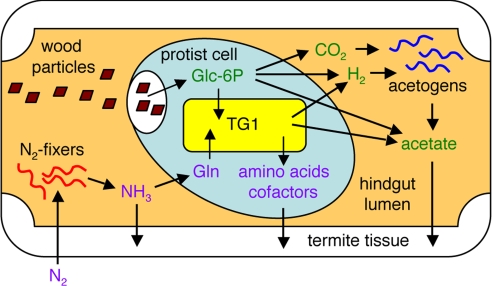Fig. 5.
Proposed schematic view of the function of TG1 bacteria in termite gut. Nitrogen is initially incorporated by some nitrogen-fixing bacteria, such as spirochetes (22). Ammonia and some amino acids in the hindgut lumen (28) are then imported by protist cells. Within a protist cell, those nitrogen compounds, including glutamine, are then converted into a variety of amino acids and cofactors by the intracellular TG1 bacteria. The protist cells probably digest TG1 cells to use these compounds because an exporting mechanism, such as that discovered in B. aphidicola (27), has not been identified in the Rs-D17 genome. The protist cells containing TG1 are then finally digested by termites during nutritional exchange via trophallaxis and by coprophagy among colony members (29). Ingested lignocelluloses are fermented by protists to CO2, H2, and acetate and by the symbiotic TG1 bacteria to H2 and acetate. CO2 and H2 are then converted to acetate by reductive acetogenesis by acetogens, such as spirochetes (30). Thus, ingested carbon sources are finally absorbed in the form of acetates by termites.

